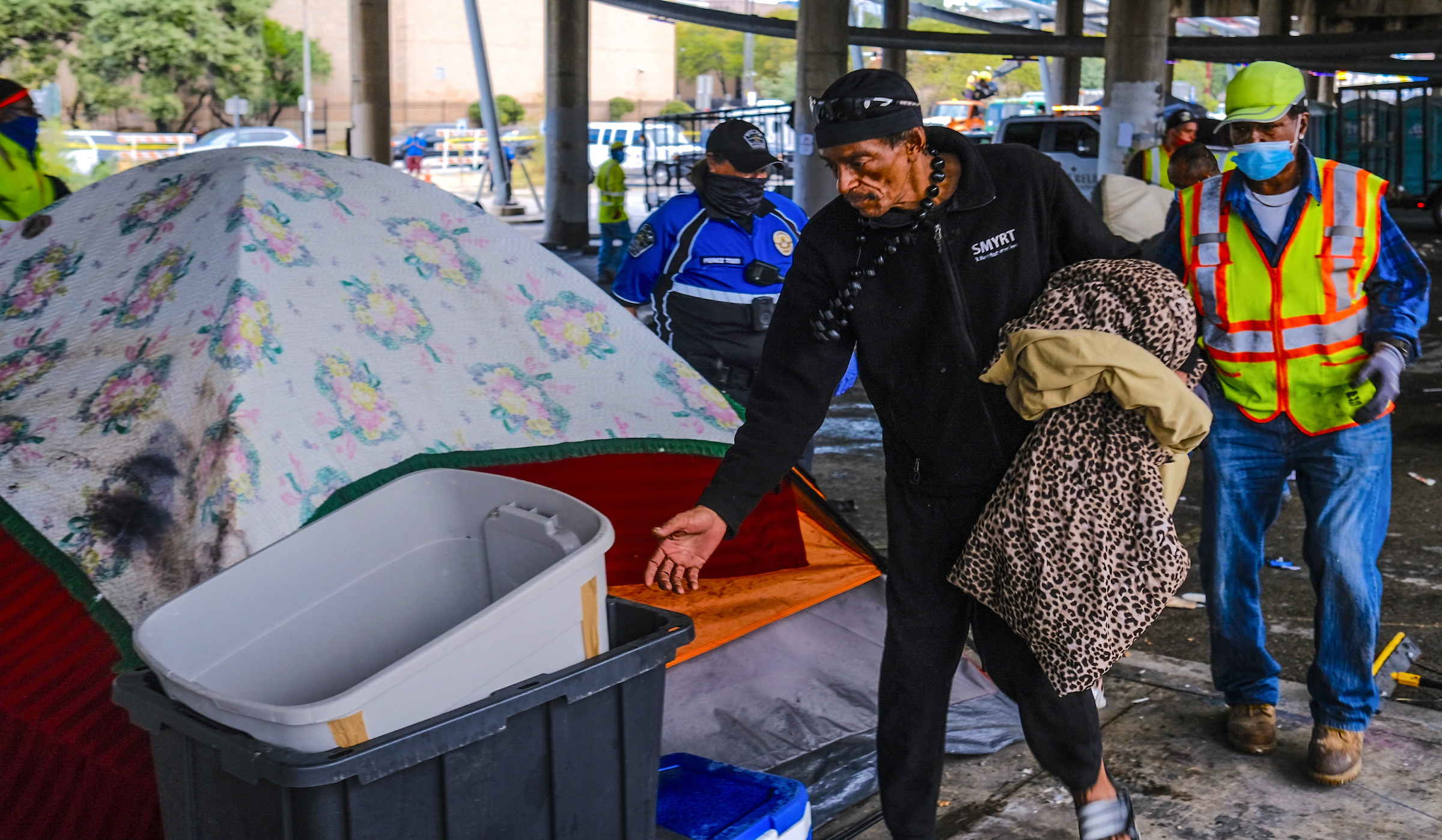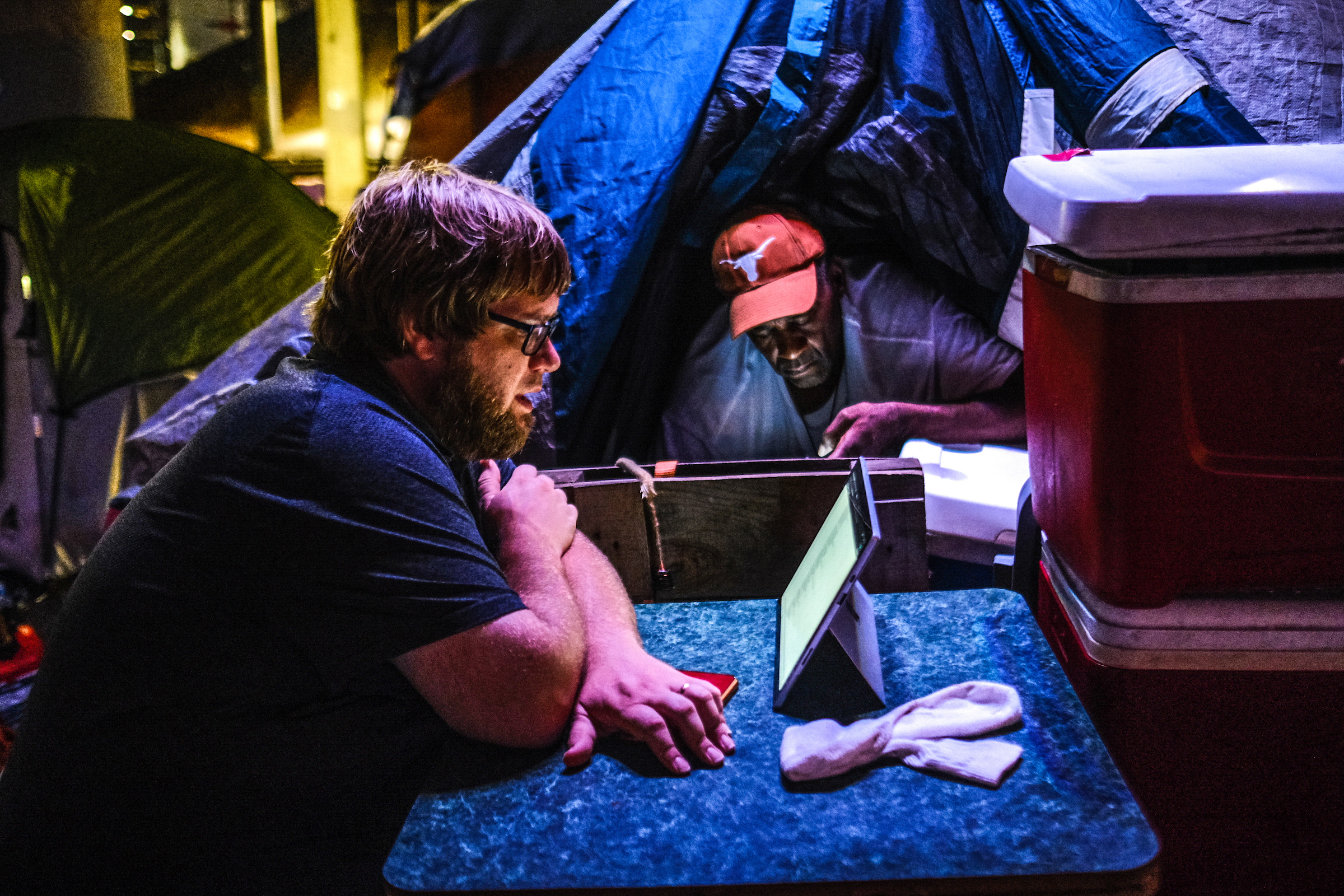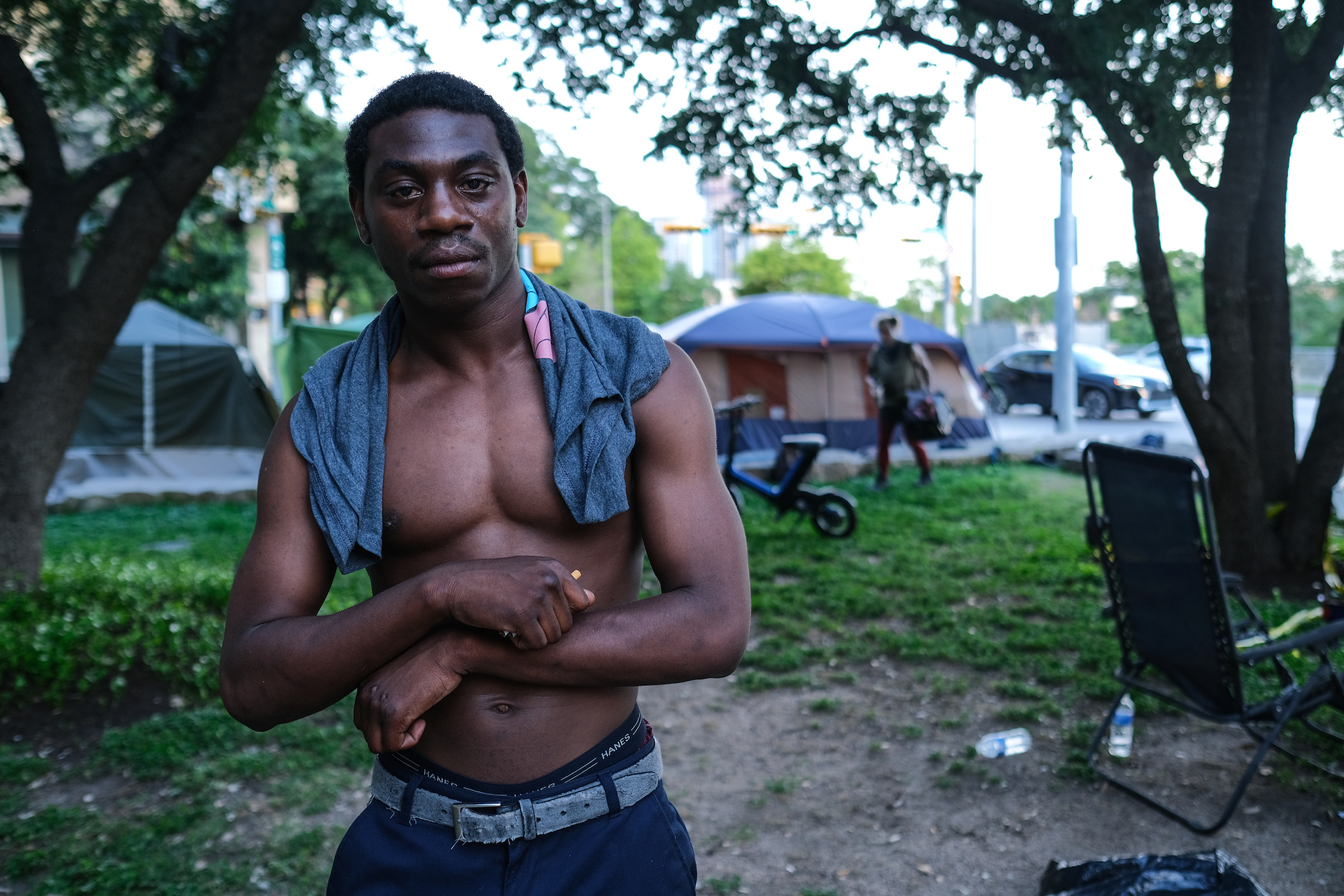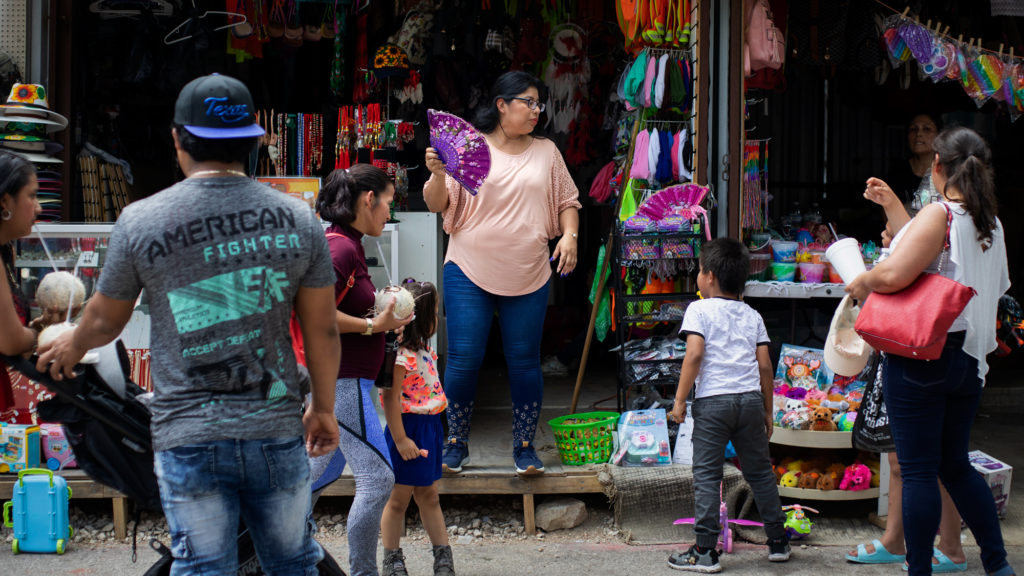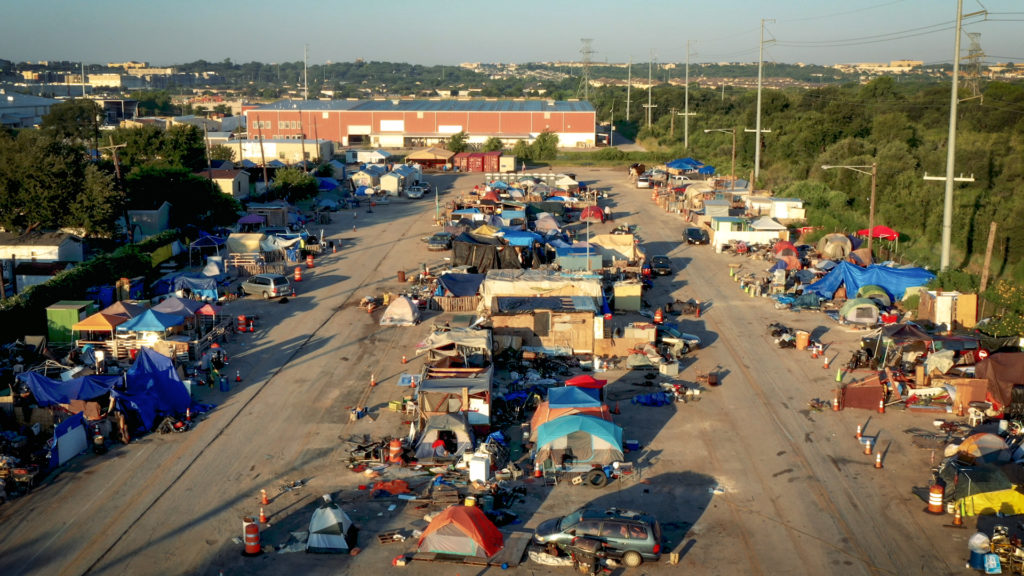The rain came around 9 p.m. Swept by gusting winds, the water streamed across the pavement beneath Interstate 35 in downtown Austin, turning some of the bedding in the homeless encampment into a soggy mess.
Earlier that day, September 28, camp residents had already braced for a major disturbance: the scheduled eviction of the premises by Austin police officers the following morning.
But on this rainy evening, as the wind whipped around their tents, knocking support poles out of place, people were more focused on keeping their homes upright for one more night.
Sandbags served as anchors, holding tents down. And the presence of Mark Hilbelink, director of the Sunrise Homeless Navigation Center, and Little Petal Alliance (LPA) activists Danielle Reichman and Chris Gould further calmed the camp as they talked one-on-one with people who’d been living in the camp for weeks or months.
A ban on public camping places new pressure on Austin’s unhoused residents
Beginning in May, when the controversial passage of Proposition B restored a ban on public camping in Austin, Reichman doubled down on her efforts to help the unhoused community. She coordinated a protest “tent-in” at Austin City Hall, camping in solidarity with those experiencing homelessness, and became familiar with the services offered by Sunrise, Austin’s only fully-integrated homeless resource center.
As the leader of LPA, a social justice nonprofit that provides support to Black, Indigenous, and People of Color, transgender individuals, and members of the unhoused population, Reichman was eager to help those living in tents place their names on housing waiting lists.
Mark Hilbelink, director of the Sunrise Homeless Navigation Center, conducts an on-site coordinated housing assessment with Rudolph Williamson on September 28, 2021, the night before Williamson and his fellow camp residents were evicted from beneath Interstate 35 in downtown Austin. Williamson, 60, expressed anger at city officials, saying members of the camp had been led to believe they would be temporarily housed in motels. “What hurts me the most,” he said, “was they said they were going to give us a place.”
She began directly communicating with Hilbelink at Sunrise, who oversees coordinated assessments — an evaluation process that determines which type of housing intervention best matches a person’s needs. Over time, the two perfected a system in which Reichman arranged for individuals to receive assessments with Hilbelink by phone.
On the night before the impending eviction of the I-35 camp, Reichman and Gould were already there, camping in protest. Reichman called Hilbelink, telling him that some of the camp’s residents desperately needed assessments. About an hour later, driving from South Austin, Hilbelink showed up with his laptop and walked from tent to tent, interviewing people and jump-starting the process of getting them into the waitlist queue for housing.
The next morning, beneath a dark and rainy sky, Austin police cordoned off the parking lot with yellow barrier tape, marking the eviction site.
“We don’t have nowhere to go,” 63-year-old camper Rose Walker said after police showed up at 6 a.m., telling people they had until 8:30 a.m. to vacate the premises and take whatever belongings they could. “They don’t care where we go. We’ve just got to go, or they’re taking us to jail. It’s as simple as that.
On September 29, 2021, Austin police officers and work crews coordinated their efforts in clearing the I-35 camp in downtown Austin. All belongings that residents couldn’t carry away were discarded, including numerous tents and a couch that belonged to camp resident Frank Lee Jackson.
Throughout the morning, piles of tents, blankets, mattresses, bicycles, clothes, steel shopping carts, and even couches were stuffed into trash compactor trucks that crushed people’s homes and many of the few belongings they owned.
By the weekend, no evidence of the camp remained, and the parking lot beneath I-35 was functioning as just that for people going to the ACL Festival and downtown bars and nightclubs. Some of those displaced found temporary shelter with the help of LPA. Others, including a man in his sixties who uses a walker and wheelchair, sought shelter wherever they could find it.
A pandemic, extreme weather events, and new policy feed a perfect storm
The I-35 camp eviction highlighted the trauma of living in Austin’s unhoused community, which, over the past few years, has endured what’s best described as a perfect storm: record-setting heat, a deadly pandemic, and a brutal Arctic blast in February 2021 that drove many people out of their tents and into motels and shelters. At least one person experiencing homelessness in Austin froze to death during the winter storm, and numerous others suffered frostbite.
In the brutal cold of Winter Storm Uri in February, members of the city’s homeless community did whatever they could to survive. Under I-35 in downtown Austin, James Smiley, at left, and X.L. “Truck” Jefferson Jr. stayed warm by a fire. Smiley also took shelter in his vehicle parked nearby.
In June 2019, months before the pandemic, Austin City Council voted to lift an earlier citywide camping ban in an effort to decriminalize homelessness and relieve some of the stress on the unhoused population.
Encampments quickly spread across the city, prompting the ire of many residents who detested the sight of them. A citizens’ group called Save Austin Now led the charge against the homeless camps and succeeded in adding Proposition B to the May 1, 2021, special election ballot.
The measure passed with more than 57 percent of the vote, again making it a criminal offense to camp in public areas or sit or lie on public sidewalks in certain areas of the city. Four months later, a similar camping ban approved by Texas lawmakers went into effect statewide. In Austin, where police have issued more than 150 tickets since the ban took effect, the policy has triggered strong reactions from those who work to support the homeless.
In the wake of the passage of Proposition B in May 2021, DeShawn Davidson joined campers for a “tent-in” protest at Austin City Hall organized by the Little Petal Alliance. Activists, concerned citizens, and members of the unhoused community pitched tents side by side to protest ballot measure, which passed and reinstated a public camping ban that had been lifted in 2019 by the Austin City Council.
Irit Umani is executive director of the Trinity Center, a nonprofit that serves unhoused people in the downtown area. She said she was glad to see people with tents for protection and shelter, rather than just a blanket on the pavement. “But I want better than that,” Umani added, referring to research that shows permanent, supportive housing is the best path to resolving chronic homelessness.
As for the camping ban, “I oppose anything that’s about chasing the problem away rather than fixing it. It’s a solution for nothing. The people we serve are the most vulnerable year-round. And they’re certainly the most vulnerable through a pandemic.”
As affordable housing becomes harder to find, homelessness becomes harder to solve
While there is no single fix for homelessness in Austin, there are plenty of options on the table. A community-wide $515 million plan that originated last spring at the Summit to Address Unsheltered Homelessness in Austin is taking concrete shape. Led by a group of city leaders, service providers, business groups, and philanthropists, the summit unveiled an ambitious goal of housing more than 3,000 homeless people by 2024.
In February, city council members approved a resolution to fund and establish the HEAL Initiative: the Housing-Focused Encampment Assistance Link, an effort to quickly house people, create a path to permanent housing, and, over time, eliminate the need for unsheltered camping.
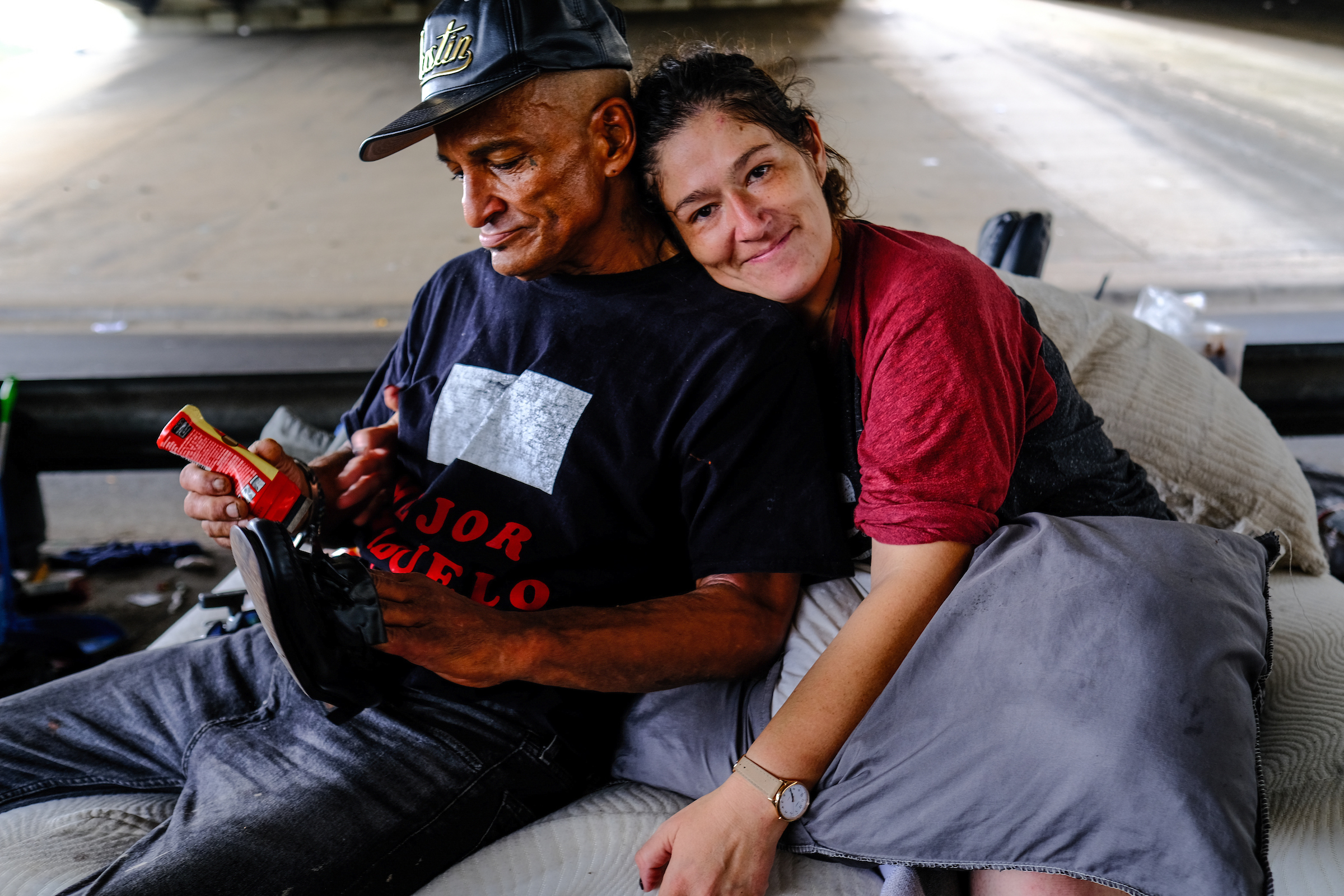
In the summer of 2021, Ronnie Vara and her boyfriend, Gabriel Willard, were living in a tent encampment beneath Ben White Blvd. at the intersection of Menchaca Rd. in South Austin. On July 11, the couple excitedly relayed the news: They and their fellow campers were being moved to a motel as part of the Housing-Focused Encampment Assistance Link (HEAL), a city initiative that seeks to reduce the number of unhoused individuals in Austin by providing outreach, relocation to temporary shelters, and a bridge to permanent housing.
The council directed City Manager Spencer Cronk to work with Dianna Grey, Austin’s homeless strategy officer, and other entities like Austin Public Health, the city’s Housing and Planning Department, ECHO (Ending Community Homelessness Coalition), and Integral Care in implementing HEAL through a three-phased approach.
Phase one, which took place over the summer, focused on housing people at four camps identified by city officials as posing risks to public health and safety because of their close proximity to vehicular and pedestrian traffic.
Through HEAL, nearly 150 people from those camps were relocated to repurposed motels referred to as bridges to permanent housing. At present, city officials are discussing the direction of the second phase of HEAL, which is set to begin in November.
Given Austin’s estimated unhoused population of more than 3,100 people, compared to the small number of individuals moved to motels, Hilbelink said he fears the initiative simply isn’t helping enough people. “Whether it really moves the needle for success in our community, I think, is probably up for debate,” he said.
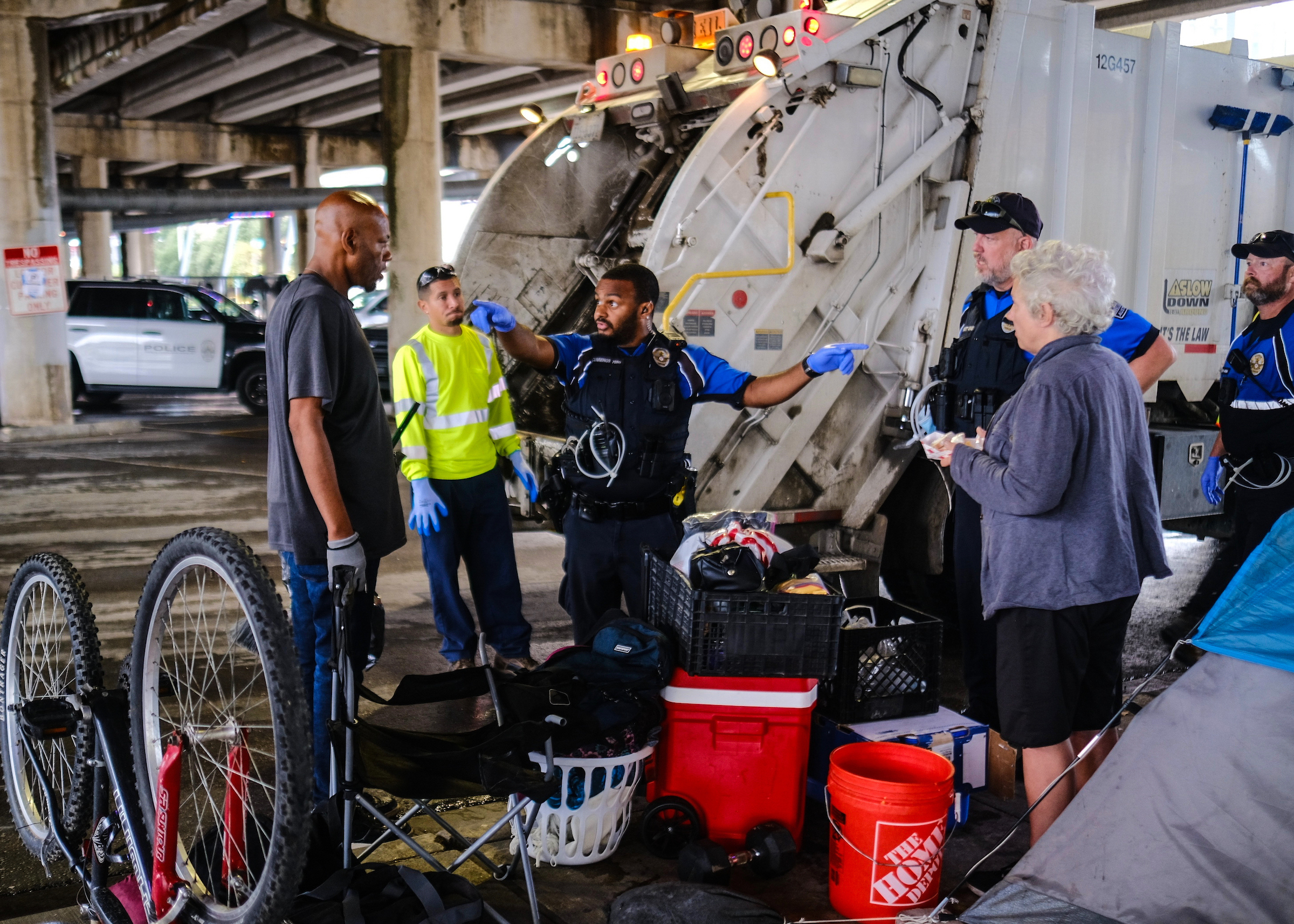
Standing next to a trash compactor truck, an Austin police officer talks to a couple about their belongings during the eviction of the downtown I-35 homeless camp on September 29, 2021.
City and county spending initiatives hold great promise for the homeless community, but they will be slow to bear fruit. Meanwhile, affordable housing becomes increasingly hard to find in Austin, where home prices have soared to some of the highest in the country. According to recent news reports, the median home price in Austin in September was $528,000, a 28 percent jump from one year ago.
Through all the changes and crises of the past two years, organizations that have long provided support for the city’s unhoused residents have carried on their efforts to create a network of support. These groups have continued their operations all the while, despite the risks, in an effort to meet the rising need.
Among these, two organizations are creating permanent housing specifically tailored for those seeking recovery from homelessness, and providing a model for what sustainable housing can look like.
Under the direction of Mobile Loaves & Fishes, the Community First! Village is expanding its master-planned community in Northeast Austin with the assistance of Austin City Council, which waived about $4 million in development fees for the construction of 1,400 new micro-homes. This new building phase is scheduled to start in 2022.
“People experiencing homelessness are often vilified,” says Mobile Loaves & Fishes president Amber Fogarty. “And that is something, for all of us as a community, that should horrify us because these are our neighbors. We know that we have to build more homes and welcome more people into the community.”

For several weeks, Frank Lee Jackson was living in a tent in downtown Austin, on a slender concrete median beside 7th Street and just below the lanes of I-35, where the roar of traffic seldom subsides. “I hear it every night,” he said. “Especially when those 18-wheelers are up there. It sounds like thunder.”
Meanwhile, in Southeast Austin, The Other Ones Foundation (TOOF) is building a transformational shelter complex at Camp Esperanza with 200 individual shelter units funded through a mix of public, private, and foundation support. The camp is being developed as a true community, with residents working in concert with TOOF to make key decisions about the future of the site.
In the midst of change, a community of support continues its ‘labor of love’
In 2020, as the pandemic worsened, the Austin Baptist Chapel Angel House was one of the few charitable organizations that remained open. Under the leadership of directors Mark and Cindy Smith, a husband and wife team who have led the soup kitchen ministry since June 2015, Angel House continued to feed the hungry on a daily basis, sometimes handing out more than 400 meals a day.
More than a year later, Mark, Cindy, and their team of volunteers soldier on at the city’s only nonprofit serving breakfast and lunch seven days a week.
“It’s a labor of love,” Mark said. “I really believe you’re not tired if you feel like you’re helping people and if you’re doing what you feel like you’re called to do.”
On a cloudy April day in 2020, Mark Smith prays with people standing in the breakfast line outside Angel House. Mark and his wife, Cindy, are directors of the nonprofit. It’s the only organization in Austin to serve breakfast and lunch to homeless people and those who are hungry seven days a week.
Both Angel House and the Sunrise Homeless Navigation Center have witnessed the respective closures of nearby camps in East and South Austin. Yet even as people have been relocated to other parts of town, the facilities continue to serve large crowds.
At Sunrise, unhoused people — many arriving by city bus — come from all over Austin for the center’s social services, which include coordinated housing assessments, a weekly medical clinic, and mental healthcare.
Hilbelink, the Sunrise center director, said the controversy surrounding the camping ban has created gridlock around the issue.
“The hardest part for me about the whole camping debate is it’s such an all-or-nothing conversation,” he said. “And what’s really messed up about that is that we, as a community, have lost the opportunity to have some really fruitful conversations about where people can be. And it makes us have a lot of silly conversations about where people can’t be.
“Do we want people at any intersection? Do we want people to be homeless at all? No,” Hilbelink continued. “We lost that entire gray [area] by only focusing on all camping, no camping. Whether you’re on the right or the left, the pawns are the homeless folks.

